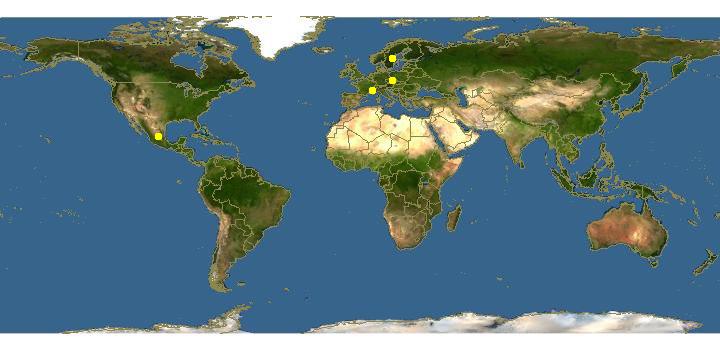
Click on map for details about points.
|
|
Overview | |
Sporocarps in dense clusters on a common hypothallus, 8-9 mm total height. Sporotheca cylindrical, slender, bent or procumbent, dark brown, 5-6 mm tall, c. 0.25 mm diam. Hypothallus membranous. Stalk black, shiny, slightly attenuate upwards, up to 33% of the total height, opaque or red brown with faint longitudinal fibres. Columella attenuate upwards, or, in some sporothecae, somewhat irregularly thickened in the central part, thin and undulate in the upper third, merging into the capillitium just below the apex. Capillitium rather lax and slender, dark brown, attenuate outwards, paler towards the periphery, joined ▒ at right angles to the columella, the internal net forming 1-3(-4) meshes across the radius, some of the axils with rather small bulbous or membranous expansions, mostly united at or just below the surface but not forming a net, giving off up to 15 Ám long, outward pointing branchlets. Spores pale brown, 7-8.5 Ám diam., conspicuously spinose-reticulate with c. 7 meshes across the diam.
|
|
|
Links to other sites | |
|
|
|
References |
- Chung,C.-H., Liu, C.-H. 1997: Notes on some myxomycetes from Kenting National Park. Taiwania 42(1): 28-33.
- Nannenga-Bremekamp,N.E., Yamamoto, Y., Sharma, R. 1984: Stemonaria, a new genus in the Stemonitaceae and two new species of Stemonitis (Myxomycetes). Proceedings.Koninklijke Nederlandse Akademie van Wetenschappen.Ser.C, Biological and medical sciences<
|
|
|
Acknowledgements | |
The Eumycetozoan Project -- working to understand the ecology, sytematics and evolution of myxomycetes, dictostelids and protostelids -- the true slime molds.
Sponsored by grants from the National Science Foundation.
|
|
|
Feedback |
Please send any corrections and comments about this page to John Shadwick
Department of Biological Sciences, University of Arkansas, Fayetteville, AR 72701, USA
email: jshadwi@uark.edu phone: USA-479-575-7393.
|
|
| Supported by | |
Updated: 2024-05-23 03:46:00 gmt
|